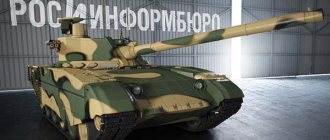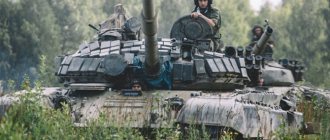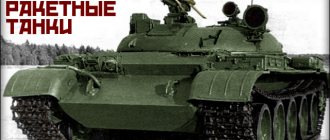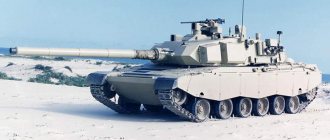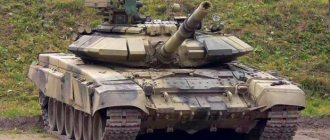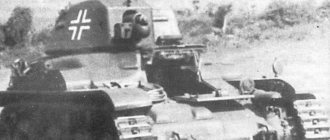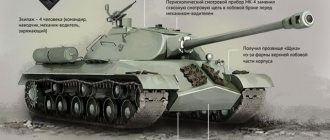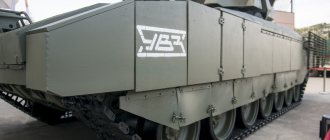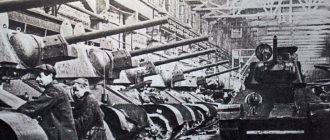Each of us knows the phrase of the Roman historian Cornelius Nepos (94-24 BC): “If you want peace, prepare for war.” Due to the fact that Russian foreign policy has recently become increasingly active (for example, intervention in the conflict between the United States and Syria, the return of Crimea, etc.), many sensible people have a lot of questions about the combat capability of our state. After all, sooner or later the scythe may come to grief, and it is unlikely that it will be possible to resolve the issue through political means, then only forceful intervention will remain. And many people understand this, which is why more and more often on various forums you can find questions of a similar nature: “How many tanks does Russia have?”, “How many submarines?” etc. Such interest reflects people's concern for the future of the country: will it be able to withstand an armed attack from, say, China or NATO forces. In this article we will answer the question of how many tanks Russia has, consider what kind of armored vehicles they are, what are their characteristics and what is the most modern tank in service in our army.
What kind of army is this?
Russian tank forces are the main striking force of the ground forces. They are mainly used in conjunction with motorized rifle units in the main directions. This branch of the military is designed to perform the following main tasks:
1. In defense - direct support of motorized rifles when repelling an enemy offensive, launching counterattacks and counterstrikes.
2. On the offensive - delivering powerful strikes that cut the front to great depths, developing success, defeating the enemy in oncoming battles and battles.
Russian tank forces are divided into brigades and battalions; they have great firepower, resistance to the damaging effects of nuclear weapons, and high maneuverability and mobility. They are able to make maximum use of the results of nuclear or fire destruction of the enemy and achieve the final goal of an operation or battle in a short time.
Combat capabilities
Russian tank divisions, their formations and subunits allow them to conduct active combat operations both day and night, in a significant separation from the main forces, conduct raids behind enemy lines, destroy enemy equipment and manpower in oncoming battles and battles, and overcome radioactive zones on the move. infection, as well as crossing water bodies. In addition, they are capable of quickly creating a very strong defense, as well as successfully resisting attacks by significantly superior enemy forces.
The development of the combat capabilities of this type of troops is carried out by equipping it with more advanced types of armored vehicles, which optimally combine the following most important combat qualities: high firepower, reliable protection and maneuverability. Combined-arms tank units play an important role in improving the necessary organizational forms. This primarily corresponds to the content of the tactics of conducting modern combat operations.
Russian tank forces: revival after decline?
The crisis that befell the Russian army in the 90s of the last century, of course, did not spare the tank troops. And the concern of ordinary people wondering “how many tanks Russia has” is completely justified. After all, the nineties literally became a black page in the history of our army. Take, for example, the rapid withdrawal of troops from Mongolia and Eastern Europe, when a lot of ultra-modern equipment at that time was left in adjacent territories, and that which was returned was, in fact, thrown into the mud, with consequences for the equipment. As a result, expensive cars were reduced to scrap metal. In addition, personnel suffered significant damage: a huge number of very promising officers with impressive combat experience were forced to leave the ranks of the armed forces.
The first “bell” for the country’s leadership was the conflict in Chechnya, when hastily assembled units, often with faulty and dismantled equipment, began to suffer serious losses. However, this tragedy did not stop the further degradation of Russian tank forces. The quality of personnel training left much to be desired, and the acquisition of new generation equipment was completely stopped. The development of new models was based on the enthusiasm of designers and engineers, as well as individual military leaders. The defense complex producing armored vehicles either became bankrupt or reoriented towards export.
The beginning of the revival
Russian battle tanks welcomed the new century while fighting in Chechnya. The sad experience of the first campaign was taken into account, and now the losses among armored vehicles were significantly less. In 2000, it was first announced that a new modern tank, known as the T-95, or “Object 195,” was being created. It was assumed that he would enter the army by 2005. However, this did not happen. The first purchases took place in 2004, but it was not the long-awaited T-95s that entered service, but the modernized T-90A, and even then in the amount of 15 units. In 2005, another 17 machines were purchased. These modern Russian tanks were the best production models at that time, but the new century also required new equipment, and the quantity of supplies clearly did not meet the requirements of the huge country. Only since 2006, purchases began to be made in acceptable quantities, in addition, the modernization of “old” equipment was actively carried out. However, the best tank in Russia (T-95) remained a dream: its deliveries were constantly delayed.
Would-be reformers
The rearmament program adopted by the Ministry of Defense specified in detail how many armored vehicles needed to be modernized and how many new tanks should be manufactured. True, it was still not clear which models should be produced: T-90A or T-95? As a result, the battered T-72B, which had survived two Chechen wars, as well as the T-62, nicknamed “museum”, were sent to resolve the Georgian conflict. The tank forces showed their best performance in this operation, as a result of which the southern group received the main Russian tank, the T-90A, into service. Probably in order to cool down the militant Saakashvili.
After the events described above, another army reform begins in the country. As a result, Russian tank forces were reduced to the level of battalions and a few brigades. The unfortunate reformers refused to purchase the T-90A, and the development of the new Burlak combat module was completely stopped. And, most importantly, Russia’s promising most modern tank, the T-95, never left the assembly line and was sent to scrap. However, the country's leadership came to their senses in time, the Minister of Defense was removed from his post and a new one was appointed. The result of such changes was a new serious project in tank building - the development of a new platform "Armata" based on the T-95 and "Object 640" ("Black Eagle"). "Armata" will be a universal platform for a new generation of armored vehicles: self-propelled guns, tanks, infantry and support vehicles, as well as repair and recovery equipment. This installation has no analogues in the world; all innovative developments of Russian design bureaus are collected here.
Still to come
2013 was a landmark year in the life of the Russian tank forces: as numerous surprise inspections have shown, many reforms did not affect the quality of combat training. Therefore, a strong-willed decision was made to sharply increase the norms of allocated ammunition. In addition, much has been done to increase the prestige of this type of troops. No matter how much they scolded the Tank Biathlon, thanks to these competitions, the citizens of our country for the first time in many years remembered that we, it turns out, still have tank troops. The Kantemirovskaya division was recreated. And currently, active rearmament and modernization of combat vehicles is underway. Already today, even though they are experienced, the first samples of the “Armata” family have already been manufactured.
However, unfortunately, it is too early to talk about results. We can only note the positive dynamics. Answering the reader’s question about what tanks are in Russia’s arsenal today, all that remains is to state the fact that the basis of our armed forces is still the fleet of old T-72B and T-80BV equipment. There is still a lot to be done to make our army truly modern.
Tanks in Russian service: T-64
This model was designed back in 1960, its mass production began in 1963, and it was put into service in 1967. The design of this vehicle used an improved version of the traditional turret layout with a rear-mounted engine compartment and separate crew accommodations. These tanks were equipped with a rifled 100-mm cannon with 50 rounds of ammunition. Monolithic differentiated armor, a two-stroke diesel power unit, and a mechanical transmission were used. The frontal elements of the turret and body are capable of withstanding a direct hit from a 100-mm armor-piercing projectile from a distance of one kilometer. As you can see, these tanks have been in Russian service for 47 years, which is already a long time. At one time, the T-60 was an excellent representative of the tank family and could compete with vehicles in service with the NATO bloc, but time passes, and the technical fleet requires modernization, and urgently.
Stagnation
It seemed that USSR tanks would take leadership in the world, but this did not happen. The First World War took place without domestic vehicles; foreign ones were used in the Civil War. In 1918, there was a clear awareness of the need to develop and produce domestic tanks. Captured French Reno-FTs, shown at a parade in Moscow, were copied at the Krasnoye Sormovo plant, creating the first example on August 31, 1920 under the name Tank M.
In 1925, production of the MC-1 began, which was distinguished by its low price and copied from the Fiat-3000. Other models were also developed. Higher in price, more difficult to manufacture, but without significant advantages.
The vicious time of imitation began, when foreign models were taken as the basis for Soviet tanks. Vickers Mk became T-26, Carden Loyd Mk VI became T-27, Vickers Medium Mark III became T-28, Independent became T-35.
A series of high-speed BTs was created on the basis of the Christie tank. They had excellent mobility due to the possibility of wheel travel, but were extremely unreliable.
T-72 battle tank
Serial production of the T-72A continued from 1979 to 1985 at the plant in Nizhny Tagil. Later, at its base they began to produce an export version - the T-72M tank, and then its further modification - the T-72M1. After 1985, the modernized T-72B and its export version T-72S went into serial production. The last tank continues to reliably serve in our army to this day. In addition, it was massively exported to Eastern European countries, India, Finland, Yugoslavia, Syria, Iraq, Kuwait and Algeria. As you can see, the geography of distribution is very extensive. It has shown excellent results in various climatic conditions, and, despite its age, continues to serve in various parts of our planet. It was equipped with diesel power units capable of reaching speeds of up to 65 km/h, and very reliable 125 mm guns. The weight of the car was 41 tons. On the basis of this tank, the BREM-1, the IMR-2 engineering vehicle, and the MTU-72 bridge laying vehicle were developed.
Modern Russian tanks
The basis of the armored forces is made up of MBTs created in the Soviet Union.
At the beginning of 1990, there were about 63,900 tanks in service and mothballed. Between 2005 and 2010 the number dropped from 23,000 to 18,000 vehicles, most of which are in storage. The army operates approximately 2,700 tanks, most of which are various modifications of the T-72, such as the T-72B or T-72B3. The latter is a cheap modification of the T-72B and has been repeatedly criticized. However, it was produced in an amount of 800 units and in some respects it catches up with the T-90.
The T-90 Vladimir was also created on the basis of the T-72B, or rather it is a very deep modernization of it. Received better armor, KOEP Shtora-1, a new turret, a powerful engine, a modern fire control system and many other improvements.
Since 2001, the T-90 has been the most popular tank in the world for 9 years. In total, more than 1,800 different modifications were released.
In 2011, the T-90AM Proryv modification appeared with a new turret, fire control system and Relikt dynamic protection.
Nothing is known about the combat use of the T-90 except for the war in Syria, where in 2016 one of them was hit by a TOW-2A ATGM, but did not receive serious damage.
It is worth remembering the gas turbine T-80, which did not gain popularity among our troops, but is a very interesting machine. As of 2016, the army has about 450 such tanks and another 3,000 in storage.
T-80 battle tank
This vehicle was put into service back in 1976. It became the world's first production model with a main power unit based on a gas turbine engine. Development of the system began back in 1955. The gas turbine engine was finally put into service in 1968. It was a power unit with a power of 1000 hp. With. The design of the combat vehicle uses elements developed and tested on the T-64A: automatic loader, gun, ammunition, individual components and mechanisms of the armor protection and fire control system. The new unit led to an increase in the mass of the tank, and consequently to a change in dynamic characteristics. As a result, the designers had to design a new chassis: tracks with rubber-coated treadmills, hydraulic shock absorbers and torsion shafts with improved characteristics, track and support rollers, and driving wheel guides.
Seven best domestic tanks (8 photos)
Author: russiatodefend
11 September 2014 17:23
Tags: Tankman's Day T-54 T-80 army IS-2 weapons T-34 T-72 tanks equipment
36460
8
The upcoming Tanker Day is a good reason to remember that tanks in Russia are not just that, but iconic national military equipment. We decided to collect for you the seven most notable domestic tanks.
1
See all photos in the gallery
0
The BT "Fast Tank" was a symbol of the mechanized units of the Red Army in the 1930s, the main tool of the so-called "deep operation". The creative development of the design of the American engineer Christie fought in Spain, the Far East and met the Great Patriotic War. In June 1941, various BT models (mainly the BT-7) were the most numerous Soviet tanks in service, not counting the truly obsolete slow-moving T-26. After the war, it was customary to treat these vehicles with disdain, but for most of the tanks in service with the Wehrmacht at the time of the invasion of the USSR, BTs were in no way inferior.
×
0
KV Heavy tank "Klim Voroshilov", with which the Soviet mechanized corps met the beginning of the war. KVs fought for quite a long time and, despite the difficulty in operation, managed to prove themselves. It was the KV that was in the hands of the crew who, on June 24, 1941, near Lithuanian Raseiniai, alone for a day (!) stopped the advance of the battle group (in fact, half of all available forces) of the 6th Panzer Division of the Wehrmacht. And Zinoviy Kolobanov controlled the KV in that battle on August 22, 1941, where he managed to knock out 22 enemy tanks.
0
T-34 (T-34-85) “Thirty-four” needs no introduction. The best tank of the Second World War saw everything - the bitterness of the first days of June 41, and the dome of the Berlin Reichstag broken by gunfire. After the war, this vehicle fought in the Middle East, Korea and Vietnam.
0
IS-2 The best Soviet heavy tank in terms of armament and armor during the war and one of the strongest tanks produced during this period. A powerful 122-mm cannon and heavy armor made it possible to use the tank when breaking through fortified enemy lines, as well as during assaults on cities.
0
T-54 (T-55) One of the most popular post-war tanks. First put into service in 1946, the T-55 version was produced until 1979 (in total, up to 44 thousand T-54 and T-55 vehicles were produced, not counting the Chinese “type 59”), after which it was modernized, receiving a guided weapon system . One of the most “war-fought” tanks of the Cold War period: behind it are the Arab-Israeli wars, Vietnam, Afghanistan and a whole bunch of local conflicts around the world, including wars in the post-Soviet space and in the former Yugoslavia.
0
T-72 Created as a mobilization tank that was cheap to produce, the T-72 managed to prove its potential and outlast its more sophisticated brothers. It became the most popular main battle tank: about 30 thousand vehicles were produced in the USSR and another 6 thousand were produced under license abroad (in India, Iran, Poland, Romania, Czechoslovakia and Yugoslavia). Following the T-55, it became one of the most “fighting” tanks in the world. Its youngest and modern descendant is the same “flying tank” T-90.
0
T-80 The world's first production tank with a gas turbine engine (there was also a diesel version), the most powerful combat vehicle of the Soviet era, the heir to the “European war tank” T-64. A fast, maneuverable tank with excellent weapons and a modern fire control system, the T-80, despite its high cost, could be considered a masterpiece of tank design.
Source:
Related links:
- Tank T-90 "Vladimir"
- Russian Internal Troops received VPK-3924 “Bear” armored vehicles
- Photo report from the international rally of military equipment - Motors of War
- Priests in the army (13 photos)
- Russian troops receive new MANPADS "Verba"
Tags: Tankman's Day T-54 T-80 army IS-2 weapons T-34 T-72 tanks equipment
Did you like the post? Support Chips, click:
354 54 302
Liked
302 5
136
Partner news
T-90 battle tank
This best Russian tank is an improved T-72B. Entered into service in 1993. The appearance of the vehicle was caused by the need to modernize (taking into account the war in the Persian Gulf) existing models of equipment, as well as the reorientation of production to exclusively Russian components, because after the collapse of the USSR, part of the defense complex remained abroad. These modern Russian tanks have a very low profile. The frontal armor of the round flat turret is reinforced with second-generation active-type tiled armor. The driver's cabin is located in the front part of the body. Above it there is a hatch and an observation system with wide-angle optics. The bow is equipped with a special acute-angled oval. The tank is equipped with a 125-mm cannon equipped with a thermally insulating casing.
What tanks are in service with the Russian army?
The basis of Russia's tank forces is made up of vehicles that have proven themselves to be excellent in all notable conflicts of the last four decades. Since the Second World War, tanks have been and remain one of the main active forces in conflicts with direct contact between opponents - so to speak, the main heavy weapon on the battlefield. Naturally, therefore, the number of tank troops also remains one of the most important indicators of the combat capabilities of the army of a particular state.
Among the world powers, three have the largest tank forces: the Russian Federation, the USA and China, and in this trio our country leads by a colossal margin. Today, according to various sources, there are about 21,000–22,000 tanks in active service and in storage in the arsenals of the Russian Army. American tank forces are armed with half the number of vehicles - 9,125 units, of which the vast majority (about 8,700) are the M1 Abrams, which were adopted almost a quarter of a century ago. A comparable number of tanks, according to various sources - from 8,500 to 9,000, is owned by the People's Liberation Army of China, where the Type 96 tank prevails, which was put into service in 1997 and, in its combat capabilities, is closest to the domestic T-72 of the latest modifications .
It is not surprising that the Russian army has the largest number of tanks in the world. After all, our country has the longest land border in the world, and in addition, Russia was forced to fight all the wars of the last two centuries, including two world wars, mainly on its own territory. Under such conditions, the concept of the use of armed forces must inevitably rely heavily on tank forces - just as the American concept of war in foreign territory overseas relies on aircraft carriers and mobile forces such as the Marines. In service and in reserve
Formally, as the official website of the Russian Ministry of Defense says, the domestic tank forces have three models of tanks: T-72, T-80 and T-90. Their number does not include the newest T-14 Armata tank, which has not yet been officially adopted for service, and was recently demonstrated to the general public at the Victory Parade in Moscow. The Ministry of Defense does not provide official data on the number of tanks of each model, but, according to independent sources, the total number of vehicles of all three models reaches 13,000–14,000 units.
In addition, the official military website does not mention the tanks stored in reserve - the T-55, T-62 and T-64, which are outdated but have not lost their combat capabilities. And there are not so few of them - almost 8000. Most of the T-55 tanks are reserved: after all, this is the most popular Soviet post-war tank of the first generation. Adopted into service in 1958, this armored vehicle was produced in quantities of over 20,000 units only in the USSR and only in its main modifications! Most of them, of course, have already been disposed of, but approximately 2,800 T-55s are stored in arsenals for conservation.
Slightly fewer—about 2,300—T-64 tanks have been mothballed. This vehicle turned out to be very successful, despite its low modernization potential, and in the West its appearance was generally compared to the entry onto the battlefield of the famous T-34. But the predecessor and contemporary of the T-64, the T-62 tank, remained in arsenals in much smaller quantities: approximately 1,600 pieces. More recently, there were almost 2,500 of them, but 900 of the vehicles were scrapped, despite the fact that the T-62 was finally removed from service only in 2011. Main tank T-72 "Ural"
Number of tanks in service: about 2000 units
Total number of tanks of all modifications produced: about 30,000 units (approximately 7,500 units are in storage)
Weight: 41 t
Armament: 125 mm cannon, 12.7 mm machine gun, 7.62 mm machine gun
Crew: 3 people
Speed on rough terrain: 35–45 km/h
Tank T-72. Photo: Vitaly Ankov/RIA Novosti
The T-72 can be considered the most massive Soviet post-war tank of all generations, which is natural: it was put into service on August 7, 1973, in the same year an initial batch of 30 vehicles was produced, and production of the model was discontinued only in 2005, that is, 32 years later! The chief designer of the tank, Leonid Kartsev, noted that foreign experts consider this vehicle “the best and most widespread tank of the second half of the twentieth century.”
Over three decades, the tank has been modernized several times: the total number of modifications, including export versions, reaches two dozen. But the main modifications were the T-72A and T-72B, as well as the more modern T-72BA and T-72B3. The first modification - T-72A - was carried out in 1979: new guidance and observation devices were installed on the vehicle, the gun was replaced with a newer one and the mounted protection was strengthened, and the engine was also changed to a more powerful one. Six years later, a modification of the T-72B appeared - with a new Svir guided weapon system, a new Kontakt dynamic protection system and a new engine, as well as a cannon - a launcher instead of a conventional cannon.
The third modification is a deep modernization of the T-72B with increased protection, including built-in dynamic protection, and more modern elements of the fire control system and the tank itself. And the latest modification - the T-72B3 - has been entering service with the troops for the last three years and is distinguished by the latest fire control system, which has significantly increased the capabilities of on-board weapons, the most powerful engine in the entire line and an improved chassis. Main tank T-80
Number of tanks in service: about 4000
The total number of tanks of all modifications produced: more than 10,000 units (of which over 6,500 are the T-80U modification)
Weight: 42–46 t
Armament: 125 mm cannon, 12.7 mm machine gun, 7.62 mm machine gun
Crew: 3 people
Speed on rough terrain: 50–60 km/h
Tank T-80. Photo: Alexey Malgavko/RIA Novosti
The T-80 was put into service only three years later than the T-72, but experts attribute it not to the second or first transitional, as “seventy-second,” but to the third generation. And quite rightly: the T-80 is the first tank in the USSR and in the world with a single gas turbine power plant. Despite the fact that in many elements this vehicle was unified with the T-72 and even with the T-64, which was the “forerunner” of both new tanks, structurally and in its basic idea it was completely new.
Due to its novelty, it received significant modernization potential, which allowed the T-80 to remain in service with the Russian army to this day. Moreover, many experts tend to consider the main modification, which was put into service 9 years later, in 1985 under the T-80U designation, as a separate model. After all, this tank was equipped with a much more modern fire control system with duplication from the commander and an updated engine, and the protection characteristics, including dynamic protection, were significantly improved. It is not surprising that it is the modernized model that is most often found in our tank forces today than other vehicles of this “family”. Main tank T-90 "Vladimir"
Number of tanks in service: about 900
Total number of tanks of all modifications produced: more than 1,800 units
Weight: 46.5 t
Armament: 125 mm cannon, 12.7 mm machine gun, 7.62 mm machine gun
Crew: 3 people
Speed on rough terrain: 40–50 km/h (depending on modification)
Tank T-90. Photo: Alexander Vilf/RIA Novosti
The tank was tested in the early 1990s under the T-72BU designation, and in fact it represents a deep modernization of this particular model. But since the characteristics and capabilities of the tank obtained as a result of alterations differed significantly from those of the “father,” it was put into service in 1992 under the designation T-90.
What distinguishes the “ninetieth” from the “progenitor”? First of all, a new fire control system, designed to replace the one that has proven itself, but is already outdated, installed on the T-72 and T-80. But the most serious changes to the tank’s equipment were made in 2006, and this modification is in service under the designation T-90A. It has a new night sight, which serves as a thermal imager, reinforced armor for the hull and turret, a new thousand-horsepower diesel engine and a new gun stabilizer.
In 1999, after the death of the chief designer of the T-90, Vladimir Potkin, his most famous creation was given the name of its creator: “Vladimir”. Four years ago, T-90 tanks stopped entering service with our army: they should be replaced by the newest T-14 “Armata” - the world’s first fourth-generation tank. But for now, the military plans to purchase only 2,300 such tanks by 2022. So, although not the newest, but still formidable and capable of many things, the T-72, T-80 and T-90 will clearly serve their country for many more years, or even more than a dozen years. The same way their predecessors served - the legendary T-55, T-62 and T-64, the heirs of the world-famous T-34.
How many tanks does Russia have?
Now let’s stop tormenting the reader and move on to the main issue of this article. Let's look at the number of tanks in Russia and list the top 10 countries by this parameter. It turns out that our country is the absolute leader here: on the balance sheet of the Ministry of Defense there are as many as 18,177 units of the mentioned military equipment. Of these, the main tanks are T-72B (7144 units), T-80 (4744 units) and T-64 (4000 units). In addition, the T-62 (689 vehicles) and T-55 (1,200 tanks) are in service. The tank forces have the smallest number of new generation armored vehicles - the T-90, with only 400 units. Agree that this is an insignificant figure for such a large army. Let's hope that the situation continues to change in the near future, and in a few years the statistics will change for the better.
Now let's see which country ranks second in our ranking. This is the United States – Russia’s main competitor in the political arena. The US Army has 9,125 tanks, of which 8,725 are M1 Ambrams. As you can see, the American military is conservative - the basis of their tank forces is only one model. Third place in the ranking is occupied by our eastern neighbor and strategic partner - China, which is armed with 8,500 armored vehicles, including 500 Type-99 tanks. The top three were far ahead of their pursuers. So, fourth place is occupied, oddly enough, by Syria with its 4,750 vehicles, most of which have a proud inscription: “Made in Russia.” Next on the list are: Turkey – 3763, India – 3569, Egypt – 3380, North Korea – 3300, Israel – 3283, and the top ten is South Korea – 2823 units.
Armored weapons and equipment of Russia. Tanks
Armored weapons and equipment of Russia. Tanks
Almanac. M.: Publishing house of the non-profit organization “Assistance League for Defense Enterprises”, 2013. – p.: 760
ISBN 978-5-904540-16
The first book from the two-volume “Armored weapons and equipment of Russia.”
This Almanac is dedicated to Soviet/Russian tanks and vehicles based on them, delivered previously and currently being promoted for export.
Brief historical information, descriptions of samples in a simple accessible form, experience in the combat use of tanks, their modifications and modernization directions reveal the stages of development of domestic post-war tank building, highlight trends in scientific research in achieving the highest combat effectiveness of armored vehicles. The most important technical characteristics are given in the tables.
The almanac contains about 2000 illustrations, many of which are unique, and is intended for specialists in the field of armored weapons and equipment, as well as for a wide range of readers interested in Soviet / Russian armored vehicles.
The sponsor of the publication is OJSC Rosoboronexport.
The publication’s partner is OJSC Research and Production Corporation Uralvagonzavod.
The almanac uses photographs of enterprises from the archives of the author-compilers, A. Khlopotov, A. Aksenov, P. Gerasimov, A. Chiryatnikov, Sh. Liessa, M. Guroshi, V. Kuzmina, M. Pavlova
In 2015, this publication became a laureate of the FSMTC of Russia “National Idea” award in the category “For contribution to the promotion of military-technical cooperation, advertising and information support for the export of military products.”
CONTENT
Opening speech by A.P. Isaykin, General Director of OJSC Rosoboronexport. Greeting from the General Director of OJSC Research and Production Corporation Uralvagonzavod O.V. Sienko Tanks. Modifications and modernization options Medium tank T-55
Modifications of the T-55 Combat use of the T-55 Modernization of the T-55
medium tank T-62
Modifications of the T-62 Combat use of the T-62 Modern modernization of the T-62 tank
T-72
tank Medium tank T -72 "Ural" Modifications of T-72 Test by fire T-72 Modern modernization of the T-72 tank
Main tank T-80
Modifications of T-80 Operation and combat use of tanks of the T-80 type Export, participation in foreign tenders T-80 Modern modernization of tanks type T-80
Main tank T-90
Modifications of the T-90S vehicle Tenders and operation of the T-90 Tank T-90MS
Armament of tanks TANK GUNS
JSC "Plant No. 9" 100-mm tank guns D-10T, D-10TG, D-10T2S 115-mm tank gun U-5TS (2A20) Family of 125-mm D-81 guns
TANK machine guns
JSC "Plant named after V. A. Degtyarev" PKT 7.62-mm Kalashnikov tank machine gun Upgraded 7.62-mm Kalashnikov tank machine gun PKTM 12.7 mm heavy machine gun NSV-12.7 "Utes" 12.7 mm heavy machine gun "KORD"
AMMUNITION
FSUE "Research Machine-Building Institute" JSC "NPO "Pribor" 125 mm artillery rounds for tank guns 30- mm shots for automatic cannons 30 mm shots for automatic grenade launchers
FIRE CONTROL SYSTEMS FOR TANK
JSC Krasnogorsk Plant named after.
S.A. Zverev OJSC Vologda Optical-Mechanical OJSC Production Association Novosibirsk Instrument-Making OJSC Kovrov Electromechanical, Zelenograd OJSC Scientific and Design Bureau of Computer Systems OJSC Elektromashina OJSC Peleng Fire control system of the T-55 tank Automated control system fire control 1A33 "Ob" of the T-80B tank Fire control system of the T-72B tank Complex and fire control system of the T-90 (T-80U) tank FCS of the modernized T-72S tank Fire control complex "Frame" of the BMPT fire support combat vehicle Fire control system "Kalina" of the modernized T-90S tank Guided missile weapon systems for tanks
JSC NPK KB Mashinostroeniya JSC Instrument Design Bureau JSC Guided missile weapon systems for tanks Guided weapon system for modernized T-55 type tanks 9K116-1 "Bastion" Guided weapon system for modernized tanks of the T-62 type 9K116-2 "Sheksna" Guided weapon system for tanks of the T-80U and T-90 type 9K119 "Reflex" Guided weapon system for tanks of the T-72B type and self-propelled guns 2S25 SPTP 2S25 "Sprut-SD" 9K120 "Svir" Anti-tank missile system "Ataka"
Means for ensuring the protection of tanks
JSC "Research Institute of Steel" - comprehensive protection of BTT JSC Federal Research and Production Anti-HEAT protection kit "Kontakt-1" for T-55/62 tanks Anti-HEAT protection kit "Kontakt-1" for tanks T-72 Anti-cumulative protection kit “Kontakt-1” for T-80 tanks Characteristics of dynamic protection elements 4S20 and 4S24 Set of additional protection for side projections of the hull and turret of T-72 and T-90 tanks Built-in lightweight dynamic protection for T-55AM tanks Universal built-in ERA "Kontakt-5" for tanks of the T-90 and T-80U types (second generation DZ) "Kontakt-5" DZ for the T-90S tank Universal modular complex of the "Relikt" DZ (third generation DZ) "Relikt" DZ for the T tank -90MS Protection against reconnaissance weapons and high-precision weapons Protective kit "Cape" Mine protection system SPMZ-2E
Active protection systems for tanks Active
protection complex "Drozd" Active protection complex "Arena-E" Curtain setting system 81-mm smoke grenade 3D6 81-mm smoke grenade 3D6M 81-mm smoke grenade ZD17
Means for ensuring tank mobility
LLC "Chelyabinsk Tractor Plant - URALTRAK" JSC "Kaluga Engine" Family of V-2 engines V-92S2 engine with gas turbine supercharging Gas turbine engines Gas turbine engine GTD-1250 and products based on it
Means for ensuring command control
JSC Concern Sozvezdie JSC Sarapul Radio VHF radio station R-173M Radio receiver R-173PM Radio station R-163-50U Radio station R-163-50K Radio receiver R-163UP Radio station R-168-25UE-2 Radio station R -168-100KBE Topographical orientation system "TRONA-1" Software and hardware systems
Combat vehicles based on tanks
OJSC "Ural Design Bureau of Transport Engineering" (UKB OJSC "Uraltransmash" OAO "Special Design Bureau of Transport Engineering" Fire support combat vehicle BMPT Heavy flamethrower TOS-1A system 152-mm self-propelled howitzer "Msta-S" Heavy combat vehicle for flamethrowers BMO-T Heavy armored personnel carrier based on the T-55 tank Highly protected command and staff vehicle of the military-technical vehicle "Ladoga"
Engineering equipment based on tanks
Armored mine clearing vehicle BMR-3MS Koleyny knife mine trawl KMT-8 Engineering clearing vehicle IMR-3M Tank bridge layers MTU Modernized bridge layer MTU-90M Landing ferry PDP Mobile means of maintenance and repair Proekt-tekhnika Corporation OJSC Central Research Institute Burevestnik Armored repair and recovery
vehicles BREM
Armored repair and recovery vehicle BREM-1 Armored repair and recovery vehicle BREM-1M Armored repair and recovery vehicle BREM-80U
Mobile means of maintenance and repair PSTOR
Workshop for maintenance and repair of weapons and military equipment of the motorized rifle (tank) battalion MTO-UB1 Repair and locksmith workshops MRS- BTM (armored weapons and equipment) and MRS-AR (missile and artillery weapons) Welding workshop MSR-M.1 (MSR-M.2) Battery charging and repair workshop MZA-M2.1 (MZA-M2.2) Workshop electrical special equipment armored vehicles MES-BTM.1 (MES-BTM.2) Inspection and testing machine 1I37E
Training facilities JSC "Training Systems" Combat vehicle crew simulators
Why all this?
From the above data it is clear that the number of tanks in Russia significantly exceeds the number of combat units of its closest competitor (almost twice). A pacifist-liberal-minded reader may burst into an angry tirade about wasted money (on the creation and maintenance of such a lot of “hardware”). However, in response, we can remind him of the ancient wisdom with which we began this article: “If you want peace, prepare for war!” After all, being weak in the modern world is dangerous. If you don’t periodically give your neighbors a hard time, you can lose, if not everything, then a lot. So, our strategic partner, China, is dreaming of how to grab Siberia for itself right up to the Urals, and the NATO bloc is already knocking on our doors from the West.
By the way, in connection with the latest events in Ukraine, we can expand our review a little. It turns out that the Ministry of Defense of Kyiv has 2,522 tanks on its balance sheet, and this is the eleventh position in our ranking. True, these statistical data were taken from our neighbors even before the start of the conflict, so after the loss of Crimea and the outbreak of hostilities in the Donetsk and Lugansk regions, this figure may decrease. After all, even official sources controlled by Kyiv reported combat losses among armored vehicles and even the defection of some military personnel to the side of the rebels. Well, okay, enough about the sad, let's go back to Mother Russia.
Armored vehicles
The first armored vehicles used in combat could be called all kinds of medieval siege machines, which were shackled with iron to reduce vulnerability. However, the first modern armored vehicles in the current sense of the word were born only in the middle of the 19th century, when in 1848, during the Austro-Hungarian conflict, history learned about the armored train. Within a decade and a half, the black smoke of steam locomotives clad in improvised armor enveloped the battlefields of the American Civil War, then the Franco-Prussian War of 1870-1871, and then, as they say, everywhere. Armored trains became a real symbol of the Civil War in Russia, and then were actively used in the Great Patriotic War, including for solving air defense problems. It’s paradoxical, but for a number of tasks armored trains have not lost their relevance to this day, and therefore some of them continue to slumber on their sidings along with armored tires.
The first armored cars appeared at the beginning of the 20th century, almost immediately after the start of the use of the car for military purposes - the idea of protecting a combat vehicle from bullets and shrapnel, and then shells, was obvious. However, before the outbreak of the First World War, armored car projects met with misunderstanding or, for the most part, theoretical interest. Armored cars armed with machine guns experienced their real heyday with the outbreak of the world conflict, and soon thundering tanks entered the battlefields. There is one obvious paradox associated with this - tanks, which are the main and most formidable class of armored vehicles, are traditionally separated from all other armored counterparts. Not only in everyday life, but also in documents, the phrase “tanks and armored vehicles” is extremely common! Now it is difficult to simply list all the possible types of modern armored vehicles - wheeled and tracked, military and police, armored vehicles and armored personnel carriers, engineering and engineer vehicles - even experts are often confused in the classification. Heavy armored personnel carriers are designed to safely deliver infantry to the battlefield, various infantry fighting vehicles support them with fire from their rapid-fire cannons, and it is difficult to imagine effective reconnaissance without armored reconnaissance and patrol vehicles. Designers are trying to cover with armor not only self-propelled artillery installations, but also artillery tractors, command and repair and recovery vehicles, ambulances and vehicles of artillery and aircraft gunners, all kinds of engineering clearing vehicles, long-armed cranes and powerful bridge layers. In any case, the Warspot portal, in articles authored by the best specialists, regularly talks about the history of the design, mass production and combat use of armored vehicles of the past, and publishes photos and videos of many modern tanks and armored personnel carriers, which are in service with various armies of the world or are just planned for delivery to units .
The future of tank building
As previously reported, the Russian army is developing the latest Armata system, which will become the basis for the creation of new types of armored vehicles. In this regard, from 2015 it is planned to begin a major modernization of mechanized and armored forces, and from next year - the introduction of a new series of vehicles into all branches of our country's troops. One such model is Russia's newest tank, the T-99. This example will be equipped with an improved version of the 125 mm gun. One of the main tasks set for the designers is to reduce the weight of the machine in order to increase maneuverability and mobility. In fact, it was these parameters that caused the T-95 and Object 195 to burn out. After all, the main task of our tanks is to protect long land borders. Armored vehicles play a key role in maintaining military parity against any threat. It should be understood that our country is distinguished not only by its vast territory, but also by very diverse climatic conditions. The designers are faced with a very serious task: the creation of such equipment that can operate reliably both in the Arctic and in the southern regions of our vast Motherland. The T-99 must meet all these conditions. The new generation tank (Russia has always been distinguished by “Kulibins”, capable of solving any seemingly impossible task) is almost ready for mass production. As stated by the Ministry of Defense, the first copies will be demonstrated to the public at the parade on May 9, 2015. So we can only wait and hope that the country will not be hit by another political crisis that could destroy any initiatives.
New Russian tanks
2015 was a festive year for those who follow the development of domestic armored vehicles. At the Victory Parade, they demonstrated the Armata platform, which has long excited the minds of tank lovers. On its basis, the T-14 Armata MBT with an uninhabited turret, the T-15 infantry fighting vehicle and several other types of equipment were created.
Lighter platforms also appeared: the medium tracked Kurganets-25 and the wheeled Boomerang. Distinctive features of the new technology are increased crew protection and unification.
When creating the Armata, the experience of developing the T-95 was used. For example, the layout of the hull, developments in the automatic loader and armor.
In 2016, new equipment should be tested for adoption and mass production. It is difficult to say how quickly it will replace aging vehicles in the army, but our country plans to produce 2300 Armata by 2022.
